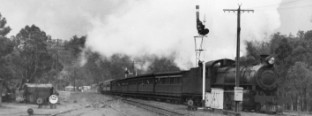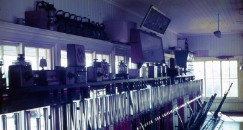Bank Engine Key Working
Block Working in WA
TRAIN ELECTRIC STAFF WORKING
FOR SINGLE LINES
BANK ENGINE KEY WORKING
In order to assist heavy trains when working along steep inclines (generally known as 'banks') to a certain location in the section being traversed, the following ingenious method was implemented.
On single lines of railways worked by Electric Staff (the example given below), the safety of the 'Bank' Engine was ensured, and was thus able to return from the starting station without the risk of colliding with another locomotive or train, whilst the assisted train continued on its journey.
On the week ending week ending Friday 18/12/1903, Pages 18, 19 and 20 of Weekly Notice 51 / 1903, proclaimed that an additional form of train working was to be brought into use on the line to Broad Arrow:-
Bank Engine Key Working.
On Saturday, 12th December, Bank Engine Key Working will be brought into force between Kalgoorlie and Broad Arrow, the bank engine working from Kalgoorlie to mileage 387 ¾ from whence it will return to Kalgoorlie.
The following special instructions are to be observed in connection with the working:-
Working of Bank Engines on Electric Train Staff Sections.
1. To facilitate the working of trains requiring assistance in the rear over steep gradients on those portions of the single line where the electric train staff is in operation, and it is not necessary for the bank engine to run the entire length of the section, the driver of the train engine will carry the staff and the driver of the bank engine in the rear of the train a “Bank Engine Key” (as described below) to enable him to return to the Station from which it was received.
2. At Stations where the electric switch lock is provided, it is attached to the electric train staff instruments, and is controlled by a special key called the “Bank Engine Key,” which, when withdrawn from the switch lock, disconnects the electric circuit of the electric train staff instrument, so that no staff can be obtained nor communication made on the instrument at either end of the section until the bank engine key has been returned to the electric switch lock. This bank engine key, which must only be carried by an engine when assisting a train in the rear, is provided with a large ring, on which is engraved “Bank Engine Key,” the name of the Station from which the bank engine starts, and the mileage to which the bank engine is authorised to run before returning.
3. If a train is assisted in the rear by a bank engine, and such engine requires to run the entire length of the section, Clause 5 of the Electric Train Staff Regulations must be strictly carried out.
4. If a train is assisted in the rear by a bank engine and the latter is not required to travel the entire length of the section, the train which is assisted must be signalled in the usual manner, and the staff obtained from the instrument. When this has been done, and the train is quite ready to start, the “Train on Line” signal must be given and acknowledged. Immediately after the “Train on Line” signal has been given and acknowledged, the “Bank Engine with Key” signal, eight beats, viz. 2, 2, 2, 2, must be given to indicate that the train is assisted by a bank engine in the rear, and that such engine will not run the entire length of the section, which signal must be acknowledged. The officer-in-charge will, after the “Bank Engine with key” signal has been acknowledged, remove the bank engine key from the electric switch lock, and take the key, together with the staff to the driver of the train engine, to whom he must deliver the staff and obtain his acknowledgment on the prescribed form, and at the same time show him the bank engine key, and, verbally inform him that such key will be handed to the driver of the bank engine. The bank engine key, together with the acknowledgment of the driver of the train engine that he is in possession of the train staff, must then be handed to the driver of the bank engine. The driver of the bank engine must intimate to the driver of the train engine that the bank engine key, together with the acknowledgment, is in his possession, by giving three whistles, viz., one long, one short, and one long; and until such intimation is received the driver of the train engine must not proceed on his journey.
5. On arrival of the bank engine at the mileage to which it is authorised to run, the driver must return at once to the station from which he received the bank engine key, and hand it to the officer-in-charge, who must place it at once in the electric switch lock, and give the “Bank Engine with key returned” signal - eight beats, viz., 2, 4, 2, which signal must be acknowledged.
6. The bank engine key must never be used or taken out of the electric switch lock for any other purpose than for a bank engine assisting a train in the rear and in accordance with these instructions. When the key is replaced care must be taken to fully turn it in the lock. The officers who are responsible for issuing the Staff and bank engine key must remain in close attendance until the train has been signalled in by the station in advance, and the bank engine has returned to the station from where the key was obtained.
7. Should the bank engine fail, the driver must hand the bank engine key to the fireman, who will take it to the station from which it was issued, and inform the officer-in-charge of the failure and the circumstances, and the officer-in-charge will then arrange for a relief engine to proceed to the disabled engine to bring it in. The driver of the relief engine must, before proceeding, be in possession of the bank engine key, which key must be handed to him personally by the fireman of the disabled engine, who must also accompany him to the place where the disabled engine was left. If, however, it is considered that assistance can be more readily obtained at the station to which the train, assisted by the bank engine, was travelling, the driver must give the fireman the bank engine key and written instructions to the officer-in-charge, authorising a relief engine to come to his assistance. The officer-in-charge, after having been informed of the circumstances, and on receipt of the written instructions of the driver must show them, to the driver of the relief engine before allowing him to proceed into the section. The fireman of the disabled engine must show the driver of the relief engine the bank engine key, and accompany the relief engine to his train, advising the driver where and under what circumstances the disabled train is situated. On arrival at the disabled engine the bank engine key must be handed over to the driver of the relief engine.
8. If a bank engine should fail when assisting a train, and the train engine is unable to take the whole of the train forward, the driver of the train engine must send his fireman back to the driver of the bank engine and obtain his assurance in writing, and indorsed by the guard of the train, that the rear portion of the train will not be moved until the train engine returns for it. The bank engine must then be removed in accordance with instructions in Clause 7. If the failure occurred in such a situation that it would be more advisable to return with the whole train to the station from which it started, this course may be adopted.
9. The disabled engine must always be taken to the station from which it started, and the driver of the relief engine must not deliver the bank engine key to the officer-in-charge until the line is clear. The fireman must not, on any account, allow the key out of his possession until he hands it over to the driver of the relief engine, and the driver of the relief engine must not allow it to pass out of his possession until the disabled engine has been removed from the section. The driver of the disabled engine must protect his engine by placing detonators on the line in both directions, in accordance with Rule 231. Where this working is adopted the staff must, in all cases, be put through the columns before being used a second time.
NOTE: This page is under development - please check back later, however, if you have any additional information on this type of train working, it would be most welcome.


